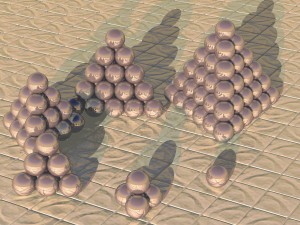We accidentally borrowed a library book for my younger son the other day – the “12 Bugs of Christmas“, a delightful little pop-up book.
I say “accidentally” borrowed. My wife reserved a book under my son’s name. When it arrived, I went to the library, showed my son’s card to the librarian, and brought home the book she gave me. This book, it turned out, was not the one my wife had reserved.
We suspect there’s another library user who shares my son’s name, whose mom is trying hard to explain to him why his “bug book” never arrived.
Anyway, this pop-up book (we had to confiscate it after my son opened it too widely and tore one of the pop-ups – thank God for superglue) is a rewrite of the popular Christmas carol “The Twelve Days of Christmas” – which always reminds me of a nice puzzle….
You can get the full lyrics of the carol here. In the song, an overwhelming number of gifts are given. The question is, how many?
- After the first day, there’s 1 gift.
- After the second day, there are 4 gifts – two turtle doves, and two pear trees.
- After the third day, there are 10 gifts (not 9, these are not square numbers) – three french hens, four turtle doves, and three pear threes.
- After the fourth day, there are 20 gifts – I’ll let you count them!
So this puzzle inspires a whole bunch of nice questions – first, some questions that just test basic arithmetic skills :-
- How many gifts are there, in total, after the full 12 days of Christmas?
- What kind of gift do they get the most of? Gold rings? Maids a-milking? Something else?
- How much would it cost to feed all the animals and people? Would you get enough if you sold the gold rings?
For a more advanced class, you could ask some more challenging puzzles :-
- What if the gift giving went on for 25 days instead of 12? Or what if it went on for a full year of 365 days? How many gifts would be given?
Finally, here’s a sort of lesson plan you could use to produce a “Eureka” moment in the kids in the class. The “Eureka” moment comes when they realize that two quite different puzzles are giving exactly the same answer. At least some of them will wonder why this is so, and (whether they find it or not) will wonder why it is so.
The first puzzle involves questions like those above. How many gifts are there after so many days? At the end, make sure the kids have drawn up a table : the first column should list how many days, for example, 1 day, 2 days, three days, and so on, up to (say) 12 days. Then, a few days later, you ask them to work on the next puzzle – the Cannonball Counting Conundrum.

Image round cannonballs, stacked into piles, each layer of cannonballs arranged as a triangle, slightly smaller than the triangle it rests on. There’s a picture on the right showing several such piles.
The puzzle is, how many cannonballs are there in each pile? As you can see, the smallest pile has just a single cannonball. If there are two cannonballs along an edge, there are four in the whole pile. The pile with three along an edge has a total of 10 cannonballs.
So, you ask your students to write up a table – one column will have the number of cannonballs along one side of the pile. The second column will show how many cannonballs are in the pile.
Lo and behold, this table ends up being exactly the same as for the “Count the Christmas Gifts” table – the left column shows 1, 2, 3, 4, 5 etc, and the right column shows 1, 4, 10, 20, 35, etc.
These numbers are called “tetrahedral numbers“, because they give the number of balls in a tetrahedron-shaped cannonball pile. They also turn up in Pascal’s triangle. Have a look at it. There’s a whole bunch of 1’s down the side. The next diagonal row of numbers, one in from the side, goes 1, 2, 3, 4, etc – just the plain old whole numbers. Then the interesting stuff starts.
The third diagonal row goes 1, 3, 6, 10, 15, etc. These are the triangular numbers, which count how many circles you need to make up a trianglular pattern. Then, the fourth diagonal row goes – you guessed it – 1, 4, 10, 20, 35, etc, the good old tetrahedral numbers.
If you show students – or better yet, let them discover for themselves – how this sequence of numbers crops up in three apparently different scenarios, it’s sure to at least pique the interest of some. Hopefully it will do get them wondering what other hidden patterns lie behind apparently plain ordinary math.